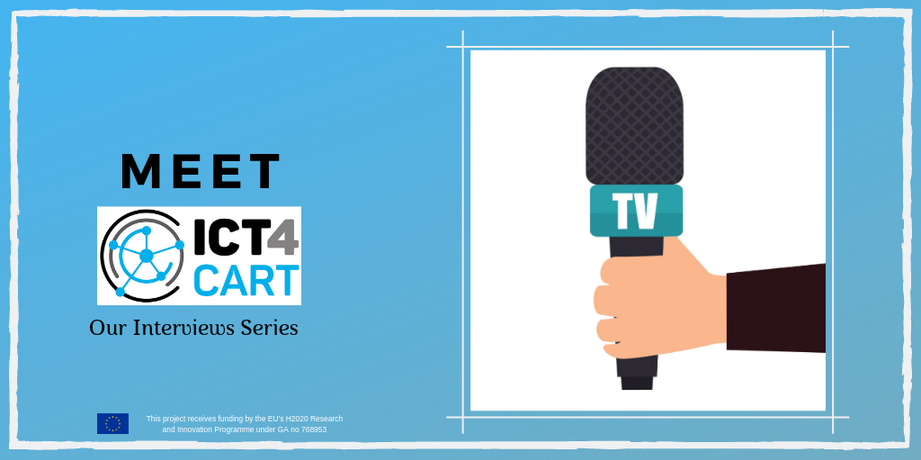Meet ICT4CART: the Interview Series, 5th appointment
- Meet LINKS Foundation: the company
The LINKS Foundation – Leading Innovation & Knowledge for Society – is a non-for-profit private Foundation, created in 2018 by Compagnia di San Paolo and Politecnico di Torino, with the aim of boosting the interaction between research and the business world towards the internationalization of the local socio-economic system. LINKS promotes, conducts, and strengthens innovation and research projects processes, improving products implementation as well as the study of new approaches and models. LINKS is the result of the merge of two distinguished research and innovation institutions: ISMB (Istituto Superiore Mario Boella), focusing on ICT, and SiTI (Istituto Superiore sui Sistemi Territoriali per l’Innovazione), focusing on Territorial Systems and Smart Cities.
LINKS is organized into Research Areas and the “Photonics and Wireless Solutions (PWS)” area, participates in ICT4CART. PWS focuses on wireless architectures (especially for vehicular communications), on multimedia processing for scalable interactive services and on photonics technologies.
- LINKS in ICT4CART: what is your role?
The role of LINKS in ICT4CART is twofold. A first role concerns the provision of the communication boards for the Italian Pilot site: they are used both as hybrid On Board Unit (OBU) for the fixed infrastructure and, on board, as Road Side Units (RSU).
Additionally, LINKS develops edge applications for safety-related purposes. These applications aim to increase the safety of both connected and automated vehicles’ users and of Vulnerable Road Users (VRUs), such as pedestrians and bicyclists.
LINKS is also involved in the evaluation of the technical impact of ICT4CART applications (LINKS leads the WP8 – Evaluation and impact assessment) based on the technical evaluation of cooperative and connected vehicle applications. Finally, LINKS leads the task on Standardization Activities thanks to its involvement in ETSI where is participating to ETSI TC ITS and ETSI MEC working groups.
- Can you explain to us what the hybrid OBU/RSU that you are developing are?
The OBU and the RSU typically implement either mobile communication technology (e.g., LTE or 5G) either the short-range communication technology ETSI ITS-G5 (deriving from WiFi and used for direct communications among vehicles or between vehicles and road-side infrastructure).
The LINKS boards can communicate using a hybrid approach, in which the two wireless media channels can be used for both enhancing safety and performing the final solution. The double channel increases relevantly the probability of correctly receiving messages.
In ICT4CART, LINKS will test and validate different approaches to identify each channel’s best use. This investigation considers also the options of Edge Computing: with this approach, the computation is provided close to the vehicles, to guarantee low-latency communication between the road-side applications and the vehicles. The low-latency values are essential for autonomous driving.
- You mentioned that you will develop also safety-related applications, can you provide an example of them?
The transition phase in which both human-driven and automated vehicles will simultaneously circulate is unavoidable, but represents a challenge for the introduction of connected and automated vehicles.
Connected and automated vehicles mutually know where they are, thanks to the periodic exchange of information about their position and dynamics. Instead, non-connected vehicles and vulnerable road users need to be identified by the connected and automated vehicles using sensors such as cameras, LiDARs or RADARs.
Under specific conditions (i.e. urban intersections or lane merging highway), on-board sensors may not be able to provide this information in advance. However, the connected and automated vehicles can receive it from the infrastructure.
LINKS is developing an application that exploits the data from several roadside fixed sensors, like cameras and LiDARs, to identify vehicles, pedestrians, bicyclists and other road users. This information is then provided by the application to the connected and automated vehicles. In this way, the autonomous vehicles have a better perception and understanding of the surrounding environment, which leads to improved safety and comfort (e.g., making smooth manoeuvres) of the passengers.
The environmental information can also be used to implement safety service to identify potential collisions, and to warn connected and automated vehicles about the potential danger.
- What is LINKS’ perspective regarding the feasibility and challenges of bringing these technologies into real-life, daily driving with automated vehicles?
The main challenge is the financial aspect, as communication boards and sensors have a fairly important cost.
At LINKS, we aim to develop practical solutions that can limit it. To achieve this, though, a specific equipment is required (a powerful for computation, flexible cameras and other sensitive sensors), and, budget-wise, the price is still substantial.
In a real future implementation, hardware cost may decrease as the production process improves or large quantities are used. Meanwhile, it is essential to limit the number of installations in the locations where this application can provide the greatest benefits. Additionally, the increased number of connected vehicles can enhance cooperation among them (and with the infrastructure) to further reduce the number of installations required.

Meet ICT4CART: The Interview Series, n. 5
